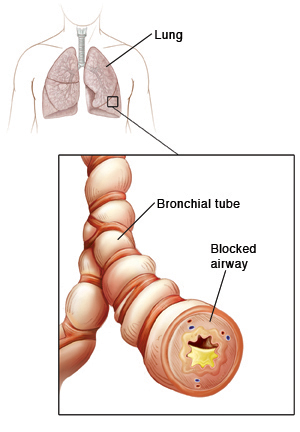A
B
C
D
E
F
G
H
I
J
K
L
M
N
O
P
Q
R
S
T
U
V
W
X
Y
Z
Click a letter to see a list of conditions beginning with that letter.
Click 'Topic Index' to return to the index for the current topic.
Click 'Library Index' to return to the listing of all topics.
Acute Bronchitis
Your healthcare provider has told you that you have acute bronchitis. Bronchitis is an infection or inflammation of the airways in the lungs (bronchial tubes). Normally, air moves easily in and out of the airways. Bronchitis narrows the airways. This makes it harder for air to flow in and out of the lungs. This causes symptoms, such as shortness of breath, coughing up yellow or green mucus, and wheezing.
Bronchitis can be acute or chronic. Acute means it happens quickly and goes away in a short time. Chronic means a condition lasts a long time and often comes back. Most people with acute bronchitis get better in 1 to 2 weeks.

What causes acute bronchitis?
Acute bronchitis is usually caused by a virus, such as a cold or the flu. In rare cases, it may be caused by bacteria. Certain factors make it more likely for a cold or flu to turn into bronchitis. These include being very young, being elderly, having a heart or lung problem, or having a weak immune system. Smoking also makes bronchitis more likely.
When bronchitis develops, the airways become swollen. The airways may also become infected with bacteria. This is known as a secondary infection.
Symptoms of acute bronchitis
Symptoms can include:
-
Coughing with mucus
-
Wheezing
-
Feeling short of breath
-
Chest pain
-
Fever
-
Feeling tired (fatigue)
Diagnosing acute bronchitis
Your healthcare provider will ask about your symptoms and health history. They will give you a physical exam. This will include listening to your lungs while you breathe. You may have a chest X-ray to look for a lung infection (pneumonia) if you have had a fever. You may also have a blood test or nose or throat swab to check for infection.
Treating acute bronchitis
Bronchitis usually goes away in 1 to 2 weeks without treatment. You can help feel better by:
-
Taking medicine as directed. Talk to your healthcare provider before taking any over-the-counter medicines (OTC). Some OTC medicines help relieve inflammation in your bronchial tubes. They can also thin mucus. This makes it easier to cough up. Your healthcare provider may prescribe an inhaler to help open up the bronchial tubes. Take any antibiotic prescribed exactly as directed. Most of the time, acute bronchitis is caused by a viral infection. Antibiotics are usually not prescribed for viral infections.
-
Ask your provider about how much fluid you should drink. Drinking plenty of fluids, such as water, juice, or warm soup can thin mucus so that you can cough it up and breathe more easily. Fluids can also prevent dehydration. However, if you have certain medical conditions, such as severe kidney disease or heart problems, you may need to limit how much you drink.
-
Using a humidifier. This can help reduce coughing.
-
Getting plenty of rest
-
Not smoking. Also, don't let anyone else smoke in your home. In public places, move away from secondhand smoke.
Recovery and follow-up
Follow up with your healthcare provider. You will likely feel better in 1 to 2 weeks. But you may have a dry cough for a longer time. Let your provider know if you still have symptoms other than a dry cough after 2 weeks. Tell them if you get bronchial infections often.
Self-care tips
To get relief from your symptoms and prevent bronchitis:
-
Stop smoking. Stopping smoking is the most important step you can take to treat bronchitis. If you need help stopping smoking, talk with your healthcare provider.
-
Stay away from secondhand smoke and other irritants. Try to stay away from smoke, chemicals, fumes, and dust. Don’t let anyone smoke in your home. Stay indoors on smoggy days.
-
Prevent lung infections. Ask your healthcare provider about vaccines, such as for the flu and pneumonia. Take steps to prevent colds and other lung infections. Stay away from crowds during cold and flu season. Stay away from others who are sick.
-
Wash your hands well. Wash your hands often with soap and water for at least 20 seconds. Use an alcohol-based hand sanitizer with at least 60% alcohol when you can’t wash your hands.
When to call your healthcare provider
Call the healthcare provider if you have any of these:
-
Fever of 100.4°F ( 38.0°C) or higher, or as directed by your healthcare provider
-
Symptoms that get worse, or new symptoms
-
Symptoms that don’t start to get better in 1 week
Call 911
Call 911 if you have:
-
Trouble breathing that doesn't get better with treatment
-
Skin, lips, or nails that look blue, gray, or pale
Online Medical Reviewer:
Chris Southard RN
Online Medical Reviewer:
David A Kaufman MD
Online Medical Reviewer:
Marianne Fraser MSN RN
Date Last Reviewed:
3/1/2024
© 2000-2025 The StayWell Company, LLC. All rights reserved. This information is not intended as a substitute for professional medical care. Always follow your healthcare professional's instructions.